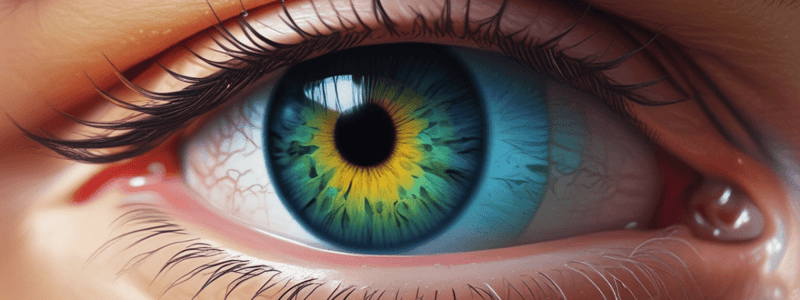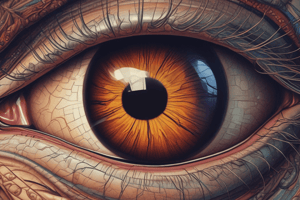Podcast
Questions and Answers
What is the function of the dilator pupillae muscle in the eye?
What is the function of the dilator pupillae muscle in the eye?
- To produce aqueous humor
- To constrict the pupil in response to bright light
- To dilate the pupil in response to low light or sympathetic activity (correct)
- To focus light on the retina
Which structure in the eye is responsible for producing aqueous humor?
Which structure in the eye is responsible for producing aqueous humor?
- Cornea
- Ciliary processes (correct)
- Canal of Schlemm
- Anterior chamber
What is the consequence of obstruction to the drainage of aqueous humor in the eye?
What is the consequence of obstruction to the drainage of aqueous humor in the eye?
- Increased production of tears, leading to watery eyes
- Clouding of the lens, leading to cataracts
- Increased intraocular pressure, leading to optic neuropathy (glaucoma) (correct)
- Decreased intraocular pressure, leading to retinal detachment
How does the lens of the eye focus light on the retina?
How does the lens of the eye focus light on the retina?
What is the cause of presbyopia, and how is it corrected?
What is the cause of presbyopia, and how is it corrected?
What is the main function of the ciliary muscle?
What is the main function of the ciliary muscle?
Which structure secretes aqueous humor into the posterior chamber?
Which structure secretes aqueous humor into the posterior chamber?
What is the action of the ciliary muscle on the lens?
What is the action of the ciliary muscle on the lens?
What is the nerve supply to the ciliary muscle?
What is the nerve supply to the ciliary muscle?
Which condition results from a loss of accommodation due to aging?
Which condition results from a loss of accommodation due to aging?
Which of the following is the correct anatomical location of the crystallins?
Which of the following is the correct anatomical location of the crystallins?
What is the primary function of the macula lutea in the retina?
What is the primary function of the macula lutea in the retina?
Which of the following conditions is characterized by increased intraocular pressure?
Which of the following conditions is characterized by increased intraocular pressure?
What is the primary cause of presbyopia, or age-related farsightedness?
What is the primary cause of presbyopia, or age-related farsightedness?
Which part of the eye is responsible for regulating the amount of light that enters the eye?
Which part of the eye is responsible for regulating the amount of light that enters the eye?
Which structure is the thinnest part of the lateral wall of the skull?
Which structure is the thinnest part of the lateral wall of the skull?
Which branch of the middle meningeal artery passes in an almost vertical direction to reach the vertex of the skull?
Which branch of the middle meningeal artery passes in an almost vertical direction to reach the vertex of the skull?
What is the consequence of bleeding from the middle meningeal artery at the pterion?
What is the consequence of bleeding from the middle meningeal artery at the pterion?
Which nerves provide sensory innervation to the dura mater?
Which nerves provide sensory innervation to the dura mater?
What type of pain is produced by stimulation of the sensory endings of the trigeminal nerve above the tentorium cerebelli?
What type of pain is produced by stimulation of the sensory endings of the trigeminal nerve above the tentorium cerebelli?
What clinical manifestation is typically seen in cavernous sinus syndrome?
What clinical manifestation is typically seen in cavernous sinus syndrome?
Where is the basilar venous plexus located?
Where is the basilar venous plexus located?
What is the main arterial supply to the dura mater?
What is the main arterial supply to the dura mater?
Which cranial nerves are at risk of damage in cavernous sinus thrombosis?
Which cranial nerves are at risk of damage in cavernous sinus thrombosis?
What can result from subsequent infection or inflammation in the cavernous sinus?
What can result from subsequent infection or inflammation in the cavernous sinus?
Which of the following statements about the arachnoid villi is correct?
Which of the following statements about the arachnoid villi is correct?
What is the primary function of the cerebrospinal fluid (CSF) produced within the ventricles of the brain?
What is the primary function of the cerebrospinal fluid (CSF) produced within the ventricles of the brain?
Which of the following anatomical structures is responsible for the referred pain sensation to the back of the neck and scalp when the dural endings below the tentorium cerebelli are stimulated?
Which of the following anatomical structures is responsible for the referred pain sensation to the back of the neck and scalp when the dural endings below the tentorium cerebelli are stimulated?
Which of the following conditions is characterized by an obstruction to the drainage of aqueous humor in the eye, leading to increased intraocular pressure?
Which of the following conditions is characterized by an obstruction to the drainage of aqueous humor in the eye, leading to increased intraocular pressure?
What is the primary function of the macula lutea in the retina?
What is the primary function of the macula lutea in the retina?
Flashcards are hidden until you start studying




